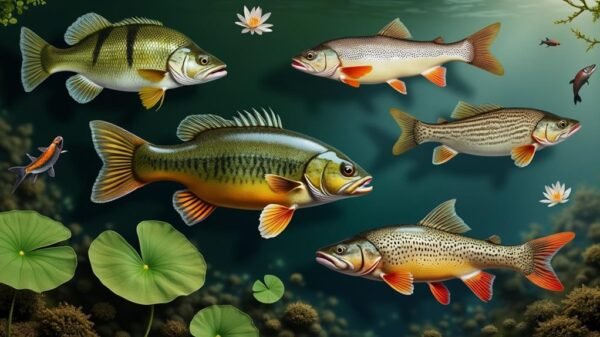Identifying common freshwater fish in lakes is key for enhancing your fishing skills and conserving ecosystems. When you know local species like Largemouth Bass or Rainbow Trout, you can choose the right bait and tackle, making your fishing trips more rewarding. Plus, recognizing different fish helps you practice responsible angling, which protects their habitats and supports biodiversity. Understanding these fish also enriches your appreciation for nature. You can start by using a field guide or engaging with local anglers. By gaining this knowledge, you'll not only catch more fish but also contribute to a healthier aquatic environment. There's more to discover on this topic!
Importance of Fish Identification
Recognizing fish species is essential for anyone engaged in freshwater angling or ecological preservation. When you understand the different species present in your favorite body of water, you can make informed decisions that enhance your fishing adventures. Identifying fish helps you catch the right types, ensuring you target populations that are abundant and legally allowed to keep. Moreover, knowing the diversity of freshwater fish, including popular types like Largemouth Bass and Rainbow Trout, is vital for responsible angling practices.
Additionally, understanding fish species significantly contributes to ecological conservation. By identifying threatened or protected species, you play a part in preserving biodiversity. It's gratifying to know that your actions can support healthy ecosystems.
Fish identification also enriches your outdoor experiences. Imagine the thrill of spotting a rare species or correctly identifying the fish you've just reeled in. This knowledge provides a deeper appreciation for the natural environment around you.
Ultimately, being knowledgeable can help you connect with fellow anglers and conservation enthusiasts. Sharing insights not only expands your network but also fosters a community committed to protecting our natural resources. So, embark on the journey of fish identification—it's an adventure that promises excitement and responsibility while allowing you to enjoy the freedom of the great outdoors.
Common Freshwater Fish Species

Knowing the common freshwater fish species in your local lakes enhances your fishing adventures and conservation practices. It's not just about catching fish; it's about understanding the aquatic ecosystem surrounding you. For example, you might encounter species such as Largemouth Bass, Rainbow Trout, or Channel Catfish. Each of these fish possesses distinct behaviors and preferred environments, making fishing thrilling and diverse.
Understanding the variety of freshwater fish can expand your knowledge and appreciation for these species. Largemouth Bass often inhabit areas near structures like submerged logs and rocky outcrops. They actively pursue artificial lures, making them a popular target for anglers using brands like Rapala and Strike King. Rainbow Trout, in contrast, flourish in cooler waters and present a challenge for many fishermen. If you're casting in a lake filled with aquatic plants, you might also discover Bluegill, which are ideal for novice anglers.
Identifying these species aids in selecting the appropriate bait and tackle. Additionally, knowing their breeding seasons can direct you to optimal fishing times. By recognizing these common freshwater fish, you will not only enhance your experience on the water but also support their conservation by understanding their requirements. So gear up with your favorite fishing equipment, head to the lakes, and dive into the captivating realm of freshwater fishing.
Identifying Fish Characteristics

When you're out fishing, recognizing the distinctive traits of various species can enhance your experience significantly. Each type of fish possesses unique characteristics that facilitate identification. For instance, knowing that largemouth bass are prevalent can assist you in targeting them effectively. Begin by observing the body shape. For instance, bass typically exhibit a sleek, elongated form, whereas catfish tend to be broader and flatter.
Next, pay attention to colors and patterns. Largemouth bass often display a dark green coloration with a lighter underbelly and a distinctive stripe along their sides. In contrast, bluegill exhibit vibrant hues, often featuring a blue spot near their gills.
Don't overlook the fins! The quantity and shape of the fins provide valuable insights about the fish. For example, trout possess a more prominent dorsal fin compared to perch.
Techniques for Species Identification

Identifying aquatic species is crucial for successful angling. Start with a reliable field guide or a mobile application like Fishbrain for fish recognition. These tools provide images, descriptions, and distinct features that facilitate species differentiation. Familiarizing yourself with popular freshwater species, such as the Largemouth Bass (Micropterus salmoides), lays a strong groundwork for your identification skills.
Next, observe the aquatic environment. Various species thrive in specific habitats. For instance, Largemouth Bass are typically found in shallower waters, while Rainbow Trout (Oncorhynchus mykiss) prefer cooler, deeper areas. Monitoring water temperature and clarity can also yield insights into the species present.
Examine physical traits such as fin shapes, body colors, and scale patterns. Noticing these characteristics can help differentiate between a Sunfish (Lepomis) and a Bluegill (Lepomis macrochirus). Document your catches, noting their sizes and markings, which will enhance your learning curve.
Lastly, engage with local anglers for advice. They often possess valuable knowledge and can share effective techniques. By integrating these strategies, you will improve your species identification and elevate your fishing experiences. Embrace the joy of discovery, and let your enthusiasm for angling flourish.
Fishing Regulations and Conservation

Fishing responsibly preserves aquatic ecosystems and ensures sustainable angling for future generations. When you fish, you enjoy nature and contribute to the health of our lakes. Understanding species diversity, such as largemouth bass and rainbow trout, enhances your fishing experience and supports conservation. Following regulations protects fish populations and their habitats.
Each state enforces specific regulations, including size limits, catch limits, and seasonal restrictions. By following these guidelines, you help maintain ecological balance. Always check local guidelines before casting your line to avoid harming a favored species.
Conservation efforts include catch-and-release practices, allowing you to enjoy fishing while minimizing impact. Using barbless hooks facilitates this process, enabling fish to swim away with less injury. Additionally, joining local conservation projects, like those organized by the Trout Unlimited or the Coastal Conservation Association, can make a significant difference.



























